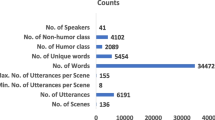Abstract
Humor detection attracts increased attention in natural language processing for its potential applications. Prior work focus on analyzing humor on isolated, textual data, but humor usually comes from the interaction among speakers in a multimodal way. In this paper, we proposed a novel dataset named MUMOR, which consists of multimodal dialogues in both English and Chinese. It contains a total of 29,585 utterances belonging to 1,298 dialogues from two TV-sitcoms. We manually annotated each utterance with humor, emotion, and sentiment labels. To our best knowledge, this is the first corpus containing Chinese conversations for humor detection. This dataset could be used for research on humor detection, humor generation, and multi-task learning on emotion and humor analysis. We released this dataset publicly.
Access this chapter
Tax calculation will be finalised at checkout
Purchases are for personal use only
Similar content being viewed by others
References
Morse, D.: Use of humor to reduce stress and pain and enhance healing in the dental setting. J. N.J. Dent. Assoc. 78(4), 32–36 (2007)
Nijholt, A., Niculescu, A.I., Alessandro, V., Banchs, R.E.: Humor in human-computer interaction: a short survey (2017)
Mihalcea, R., Strapparava, C.: Making computers laugh: Investigations in automatic humor recognition. In: HLT/EMNLP 2005, Human Language Technology Conference and Conference on Empirical Methods in Natural Language Processing, Proceedings of the Conference, Vancouver, Canada, 6–8 October 2005, pp. 531–538 (2005). https://www.aclweb.org/anthology/H05-1067/
Zhang, R., Liu, N.: Recognizing humor on twitter. In: Proceedings of the 23rd ACM International Conference on Conference on Information and Knowledge Management, CIKM 2014, Shanghai, China, 3–7, November 2014, pp. 889–898 (2014). https://doi.org/10.1145/2661829.2661997, https://doi.org/10.1145/2661829.2661997
Castro, S., Cubero, M., Garat, D., Moncecchi, G.: Is this a joke? Detecting humor in spanish tweets. In: Montes-y-Gómez, M., Escalante, H.J., Segura, A., Murillo, J.D. (eds.) IBERAMIA 2016. LNCS (LNAI), vol. 10022, pp. 139–150. Springer, Cham (2016). https://doi.org/10.1007/978-3-319-47955-2_12
Khandelwal, A., Swami, S., Akhtar, S.S., Shrivastava, M.: Humor detection in english-hindi code-mixed social media content : corpus and baseline system. In: Proceedings of the Eleventh International Conference on Language Resources and Evaluation, LREC 2018, Miyazaki, Japan, 7–12, May 2018 (2018). http://www.lrec-conf.org/proceedings/lrec2018/summaries/363.html
Blinov, V., Bolotova-Baranova, V., Braslavski, P.: Large dataset and language model fun-tuning for humor recognition. In: Korhonen, A., Traum, D.R., Màrquez, L. (eds.) Proceedings of the 57th Conference of the Association for Computational Linguistics, ACL 2019, Florence, Italy, July 28- August 2, 2019, Long Papers, vol. 1, pp. 4027–4032. Association for Computational Linguistics (2019). https://doi.org/10.18653/v1/p19-1394
Bertero, D., Fung, P.: A long short-term memory framework for predicting humor in dialogues. In: NAACL HLT 2016, The 2016 Conference of the North American Chapter of the Association for Computational Linguistics: Human Language Technologies, San Diego California, USA, 12–17, June 2016, pp. 130–135 (2016). https://www.aclweb.org/anthology/N16-1016/
Bertero, D., Fung, P.: Multimodal deep neural nets for detecting humor in TV sitcoms. In: 2016 IEEE Spoken Language Technology Workshop, SLT 2016, San Diego, CA, USA, 13–16, December 2016, pp. 383–390 (2016). https://doi.org/10.1109/SLT.2016.7846293
Liu, L., Zhang, D., Song, W.: Modeling sentiment association in discourse for humor recognition. In: Proceedings of the 56th Annual Meeting of the Association for Computational Linguistics, ACL 2018, Melbourne, Australia, 15–20, July 2018, Short Papers, vol. 2, pp. 586–591 (2018). https://doi.org/10.18653/v1/P18-2093, https://www.aclweb.org/anthology/P18-2093/
Poria, S., Hazarika, D., Majumder, N., Naik, G., Cambria, E., Mihalcea, R.: MELD: a multimodal multi-party dataset for emotion recognition in conversations. In: Proceedings of the 57th Conference of the Association for Computational Linguistics, ACL 2019, Florence, Italy, July 28- August 2, 2019, Long Papers, vol. 1, pp. 527–536 (2019). https://www.aclweb.org/anthology/P19-1050/
Ekman, P., Friesen, W.V., O’sullivan, M., Chan, A., Diacoyanni-Tarlatzis, I., Heider, K., Krause, R., LeCompte, W.A., Pitcairn, T., Ricci-Bitti, P.E., et al.: Universals and cultural differences in the judgments of facial expressions of emotion. J. Pers. Soc. Psychol. 53(4), 712 (1987)
Hasan, M.K., et al.: UR-FUNNY: a multimodal language dataset for understanding humor. In: Inui, K., Jiang, J., Ng, V., Wan, X. (eds.) Proceedings of the 2019 Conference on Empirical Methods in Natural Language Processing and the 9th International Joint Conference on Natural Language Processing, EMNLP-IJCNLP 2019, Hong Kong, China, 3–7, November 2019, pp. 2046–2056. Association for Computational Linguistics (2019). https://doi.org/10.18653/v1/D19-1211
Castro, S., Hazarika, D., Pérez-Rosas, V., Zimmermann, R., Mihalcea, R., Poria, S.: Towards multimodal sarcasm detection (an \_obviously\_ perfect paper). In: Korhonen, A., Traum, D.R., Màrquez, L. (eds.) Proceedings of the 57th Conference of the Association for Computational Linguistics, ACL 2019, Florence, Italy, July 28- August 2, 2019, Long Papers, vol. 1, pp. 4619–4629. Association for Computational Linguistics (2019). https://doi.org/10.18653/v1/p19-1455
Author information
Authors and Affiliations
Corresponding author
Editor information
Editors and Affiliations
Rights and permissions
Copyright information
© 2021 Springer Nature Switzerland AG
About this paper
Cite this paper
Wu, J., Lin, H., Yang, L., Xu, B. (2021). MUMOR: A Multimodal Dataset for Humor Detection in Conversations. In: Wang, L., Feng, Y., Hong, Y., He, R. (eds) Natural Language Processing and Chinese Computing. NLPCC 2021. Lecture Notes in Computer Science(), vol 13028. Springer, Cham. https://doi.org/10.1007/978-3-030-88480-2_49
Download citation
DOI: https://doi.org/10.1007/978-3-030-88480-2_49
Published:
Publisher Name: Springer, Cham
Print ISBN: 978-3-030-88479-6
Online ISBN: 978-3-030-88480-2
eBook Packages: Computer ScienceComputer Science (R0)





